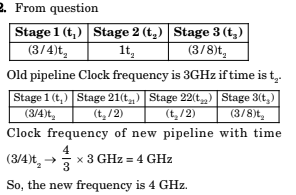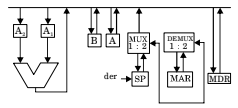Computer System Architecture - Pipeline and Vector Processing
- Option : B
- Explanation : In a line, there can be three possibilities :
1. Stuck-at 0 fault
2. Stuck-at 1 fault
3. No fault
Thus, total combinations = 3N
It is mentioned that one or more lines have stuck at faults.
So, a case in which there is no fault in any line i.e. all lines are correct can not occur.
Total combinations = 3N – 1
- Option : A
- Explanation : 0.8 * (time taken in fixed point) + 0.2 (time taken
in floating point) Say, t = 1
D = 0.8(1) + 0.2(2)
= 1.2
D1 = 0.8(1.3) + 0.2(1.4)
= 1.04 +.28 = 1.32
D2 = 0.8(1 – 0.04) + 0.2(2 – 2*0.1)
= 0.8 * 0.96 + 0.2 * 1.8
= 0.768 + 0.36 = 1.128
D1 > D > D2




